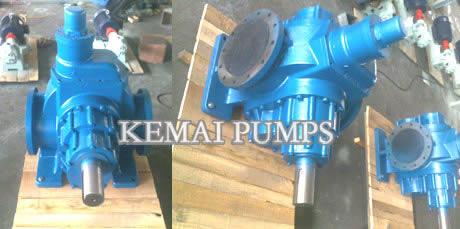A pump formed by two gears meshing with each other is called gear pumps.
The flow formula of the gear pump is:
Q=2qZnηv
Z——Gear number;
n——Speed (RPM);
ηv——Volumetric efficiency for general gear pumps,It is generally 0.70~0.90;
q——The volume of the pit between two gears.
As the gears turn, the drawn fluid fills the pit between the teeth and the gear and is transported along the housing wall to the pressure space.
Here, due to the intermeshing of the two gears, the liquid in the pit is extruded and discharged into the pressure tube.
When the liquid is squeezed, the pressure ACTS on the gear and exerts a radial load on the shaft.
After compression, the closed space gradually increases, forming a negative pressure zone, and the external liquid flows into the gear pump suction inlet under the action of atmospheric pressure.
In addition, as the volume of the closed space increases in the negative pressure area, air and water vapor in the liquid will be separated out, and the cavitation effect similar to cavitation will occur, causing damage to the gear surface.
Because of this, some gear pumps have a balancing hole or chute.
In most cases, however, helical gears are used;
Because the volume of the closed space of the helical gear is almost constant when meshing, that is, when the volume of one part increases, the volume of the other part decreases.
So it’s not serious.
2CY gear pump is characterized by good self-absorption performance, simple construction and reliable operation.
From the above formula, it can be seen that for a certain gear oil transfer pump (size D, D, b and n are all fixed values), its oil discharge is also determined, which is a constant fixed value.
So its characteristic curve is a vertical line (that is, no matter how the external pressure changes, its oil discharge is fixed).
Because the outlet and inlet of the gear pump are isolated, when the external oil demand decreases, the pressure of the outlet pipe will rise sharply, causing the explosion of the outlet pipe and pump shell.
Therefore, a safety valve is provided at the outlet (or outlet pipe) of the gear pump, which ACTS when the pressure is raised to a certain degree to drain part of the oil in the outlet pipe.
The characteristic curve is in the high pressure area, and the flow direction is small, which is mainly caused by the leakage of the liquid in the pump along the tip clearance from the outlet to the inlet when the pressure is high.
- During the overhaul of gear pump, the main measurement clearance is:
- 1. Shaft clearance between the end face of the gear and the pump housing is generally about 0.20mm.
Measure with lead wire. - 2. The radial clearance between the outer circle of the gear and the pump housing is generally 0.10~0.15 mm (but larger than that of the bearing shell) in the radius direction, or it can be selected according to the diameter of 0.003~0.005 (refer to the total clearance).
Measure with a feeler. - 3. Generally, the gap between the meshing parts of the two gears should be 0.30mm. If the gap is too large, it will accelerate wear, and if it is too small, it will cause fever and bite.
Measure with lead wire. - 4. For bearing shell clearance, 0.06~0.12 mm should be taken when the diameter of the bearing is 20~40 mm.
Measure with a feeler or vernier caliper.
The meshing part of the gear should be kept unchanged before and after maintenance.
When the gear pump is running, it is not allowed to close the outlet valve. When starting and stopping, it should also keep the outlet valve in the open position and only operate the inlet valve.


